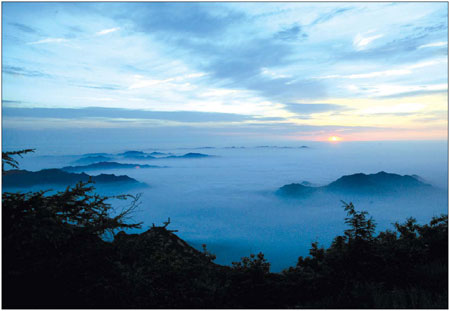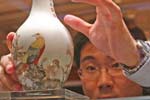Tips and Articles
View to a thrill
Updated: 2011-02-25 10:06
By Erik Nilsson (China Daily European Weekly)
 |
|
According to ancient Chinese creation myths, Taishan was the point |
If you want to climb one of the world's great mountains, go to Mount Taishan
Separated from Beijing by a small slice of Hebei to the south, Shandong province proffers a week's worth of wonderment that is refreshingly different from the Chinese capital. Majestic mountains and splashing springs make the provincial capital, Jinan, a common launch pad for excursions throughout Shandong.
The urban sprawl of the city of 1.9 million packs the cracks among Mount Taishan's foothills, creating a cityscape in which craggy peaks compete with shiny high-rises for lordship over the skyline.
Here are five highlights:
1. Qianfoshan
The summit most worthy of ascent is Qianfoshan (Thousand Buddha Mountain), where tens of thousands of Buddhas populate this 258-m-tall peak.
Some 23,000 stone-carved Buddhas, bodhisattvas, disciples and guardian kings lurk in Wanfo Cave - Qianfoshan's biggest burrow - alone.
The southernmost cliff face is bearded with 130 carved Buddhas and pocked with the openings of the Longquan, Jile, Qianlou and Luzhu caves.
Visitors can ride a cable car most of the way up the mountainside and return to base on a sled, rocketing along an 87-m-long metal half-pipe winding down the mountainside. Spring seekers have long looked to the city as an oasis in the semiarid province.
2. Baotuquan
While the aquifer upon which Jinan is built spurts through the bedrock in several spots, Baotuquan is the most famous of these once-fantastical fountains.
Industrialization and overpopulation, however, have absorbed much of Baotuquan's momentum and for most of the year, the spring gurgles rather than gushes. But a picturesque park built in the style of southern China and a pair of playful seals splashing in one of its pools make visiting Baotuquan worthwhile.
3. Jade Emperor's Peak

"Sun worshipers" flock daily to the range's tallest summit, Jade Emperor's Peak, to see the sun rise and set from above the clouds.
According to many ancient Chinese creation myths, Taishan was the point from which the world originated. Every day, the legends told, began with the sun rising from Taishan to start its westward journey across the world. Today, the mountain is still revered as a peak for Buddhism and as a Taoist god.
Those hoping for a journey of historical proportions should follow the Imperial Route up the mountainside. Here, more than 6,000 steps snake up China's greatest topographic treasure. Carved calligraphy serves as testimonial to past cameos by China's most acclaimed literati and rulers.
Those seeking something a bit more off the beaten path can slug up the wilder Western Route. However, they'll come across few historically significant spots, aside from the Longevity Bridge, which spans a small waterfall feeding the Black Dragon Pool.
Reserved for real-deal adventurers is the treacherous Tianzhu Peak Route. This summit takes its appellation from the resemblance it bears to a candle, upon which stands a lone pine that is reminiscent of a flame.
This track winds under the shadows of centuries-old pines and several other peaks, including General Peak and Small Tianzhu Peak. The most impressive site found along the way is the Eight Immortals Cave.
Those who are unable or unwilling to abuse their feet can catch a bus (18 yuan, 2 euros) up the mountain to Zhong Tian Men (Middle Heaven's Gate), which is also the destination point of the Western Route.
Upon reaching Zhong Tian Men, visitors can take an 11-minute cable car ride over mountain valleys to Jade Emperor Peak for 45 yuan.
The western side of Jade Emperor Peak is a superlative vantage point for watching the setting sun sinking into the cloud swath below. Upon taking a stone bridge eastward, travelers will find something resembling a small but bustling town.
Skirting among the traditionally styled structures is an army of sun worshipers clad in People's Liberation Army jackets, which can be rented for as little as 5 yuan per night, to seal out the chilly mountaintop winds.
4. Qufu
As the hometown of Confucius and Mencius, Qufu's main claim to fame is having shaped two sages of the ages.
Today, the tiny town of Qufu is essentially a museum of Confucius, where visitors can see the house in which he was born, the graveyard in which he was buried and the temple built to honor him after his passing.
The Confucius Temple (90 yuan) warehouses several pagoda-covered inscriptions, the only dragon-carved columns found outside of the Forbidden City during ancient times and courtyards populated with centuries-old cypresses.
Spanning 22 hectares, the 466 buildings in this walled-in temple take up one-fifth of the area of the city.
At the Kong Family Mansion, visitors can see the opulence in which Confucius' descendents lived on the coattails of their nomadic ancestor's destitute death.
5. Confucian Forest
North of town in Qufu County, visitors can bike the Confucian Forest. This graveyard for Confucius and his disciples spans more than 200 hectares and is shaded by thousands of ancient trees - said to have been planted by the sage's disciples.
Those looking to make more than a day out of Qufu can also visit the Duke of Zhou Temple (Zhougongmiao), the Duke of the State of Liang Woods (Lianggonglin), the Mother of Mencius Woods (Mengmulin) and the ruins of the ancient city of the Ducal State of Lu. With a population of 620,000 dwelling in an area of 896 sq km, travel in Qufu is best done on foot.
Specials

Share your China stories!
Foreign readers are invited to share your China stories.

Art auctions
China accounted for 33% of global fine art sales.

Waiting for drivers' seat
Lack of sponsorship appears to be why Chinese drivers have yet to race in a Formula 1 event